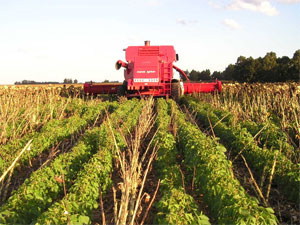Australia
March 31, 2006
The inter-cropping technique
typically used by subsistence farmers to maximise food
production on their small blocks of land could help Australian
graingrowers in their constant battle against the cost price
squeeze.
According to Dr Victor Sadras, a crop scientist with South
Australia's Research and Development Institute, trials in
high-tech farming systems in Argentina have shown that
sunflowers on 1.4 metre rows can be inter-planted with soybeans
with only minor effects on sunflower yield.
So, Dr Sadras says, whatever yield is taken from the soybeans
and they are affected by shortage of water and by shade from the
taller sunflower plants in their early stages is extra
productivity and profit.
The inter-cropping technique developed by Dr Pablo Calviño was
explained by Dr Sadras at the recent 15th Australian Sunflower
Conference in Gunnedah.
The conference's major financial
supporters were the Grains
Research and Development Corporation (GRDC), the Australian
Oilseeds Federation and the NSW Department of Primary
Industries.
|
 |
|
Inter-cropped soybeans really get into their stride once
the shading sunflower heads are harvested. Photo by Dr
Pablo Calviño. |
He said the ideal would be to
improve farm productivity by at least as much as the decline in
the terms of trade, but that would require innovative farmers
and advisers, open-minded researchers, funding bodies ready to
take risks and interaction between all of them.
The inter-cropping of sunflowers and soybeans in Argentina
which was the main subject of his presentation to the conference
and winter sunflowers in Spain were examples of the innovative
thinking required.
Researchers in Argentina knew sunflowers could maintain yield on
1.4 metre rows and that sunflower plants had the ability to
incline their stems alternatively left and right to reduce
competition for radiation and effectively increase biomass
production.
While sunflowers¹ ability to capture radiation was good,
researchers had decided to find out whether a second crop in the
same field planted in that 1.4 metre gap between the sunflower
rows would use more of the available radiation.
Late-sown soybean was the choice for inter-cropping, partly
because its critical growth period did not overlap that of
sunflowers.
Trials proved sunflower yield was not affected by two
inter-planted rows of soybeans but the bean crop did struggle
until the shade influence of the sunflowers was removed at
harvest.
Ongoing work on crop configurations was targeting this 'weak
link' in the system.
Dr Sadras said large farms in Argentina were now using the
inter-cropping system and, in some cases, attaining close to the
ideal yield sunflowers might achieve when planted on their own.
The Argentine trials were in an area with an annual rainfall of
about 900 millimetres and possibly more relevant to irrigation
growers in Australia.
But the system was an excellent example of innovative thinking
turning a subsistence farming concept into a high-tech solution
to productivity. |